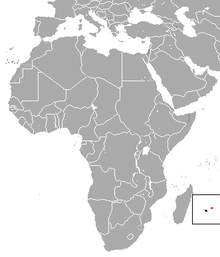Mauritian flying fox
| Mauritian flying fox | |
|---|---|
 |
|
| Scientific classification | |
| Kingdom: | Animalia |
| Phylum: | Chordata |
| Class: | Mammalia |
| Order: | Chiroptera |
| Family: | Pteropodidae |
| Genus: | Pteropus |
| Species: | P. niger |
| Binomial name | |
|
Pteropus niger Kerr, 1792 |
|
 |
|
| Mauritian flying fox range (red — extant, black — extinct) |
|
The Mauritian flying fox (Pteropus niger), also known as Greater Mascarene flying fox or Mauritius fruit bat is a large megabat species endemic to Mauritius and La Réunion.
It can reach a wingspan of 80 cm, so is the largest endemic mammal on Mauritius. Its fur is golden. It has small ears, thick hair on the tibiae, dorsal coloration of glossy, blackish brown mantle, tinged with rufous, which extends posteriorly into a dark brown median spinal tract, flanked by buff lateral patches. It is a medium-sized species; the adult forearm length averages 152 mm, with no difference between males and females. Mostly nocturnal, although some are occasionally seen during the day, they normally roost by sunrise. These fruit bats range in size from 40-800 g and occur from sea level to 1500 m above.
Representative samples of flying foxes (genus Pteropus) in the Philippines came from different islands of the country. The split of Pteropus species from their megabat relatives was between 28.37 and 34.63 million years ago. Within the genus, the first evolutionary event arose probably between 12.41 and 15.39 million years ago.
Fruit bats, such as the P. niger, are extremely important to the Western Indian Island ecosystems. Their role in these ecosystems is as pollinators and seed dispersers.P. niger currently resides on the island of Mauritius. It became extinct on the island of Réunion between 1772 and 1801, but may more recently have recolonized the island from Mauritius.
They roost in large groups and are active at dusk and dawn. Their diets consist of fruit and nectar, making them important seed dispersers and pollinators.
P. niger is a pollinator and seed dispenser. As less than 1.9% of the island supports native vegetation, and reproduction of plant species is poor, the survival of this species is important to the ecosystem as whole. One study (conducted from October 1999 to April 2000) looked at two large roost areas in Bel Ombre, each consisting of at least 400 individuals. No roosts of the bats exist in village areas. The bats are mostly located in the Bel Ombre forest, with some smaller populations in the Combo Forest and Black River Village.
It consumes mostly fruit and some fauna, when available or absolutely necessary. The study found the bats consumed 20 species of plants, 18% of which were native to Mauritius. Of those native species, 36% are either vulnerable or rare. The bats dispersed many seeds from these plants in flight through their feces. This is ultimately advantageous to many of the native species (mostly fruit species, which make up the majority of the bats' diets) They also found P. niger is an opportunistic feeder, mostly adapting to and eating whatever plants or fruits are available to it at the time. While little evidence supported P .niger as valuable in the pollination process, its role as a seed dispenser is important to the survival of many species of plant life on Mauritius.
...
Wikipedia

